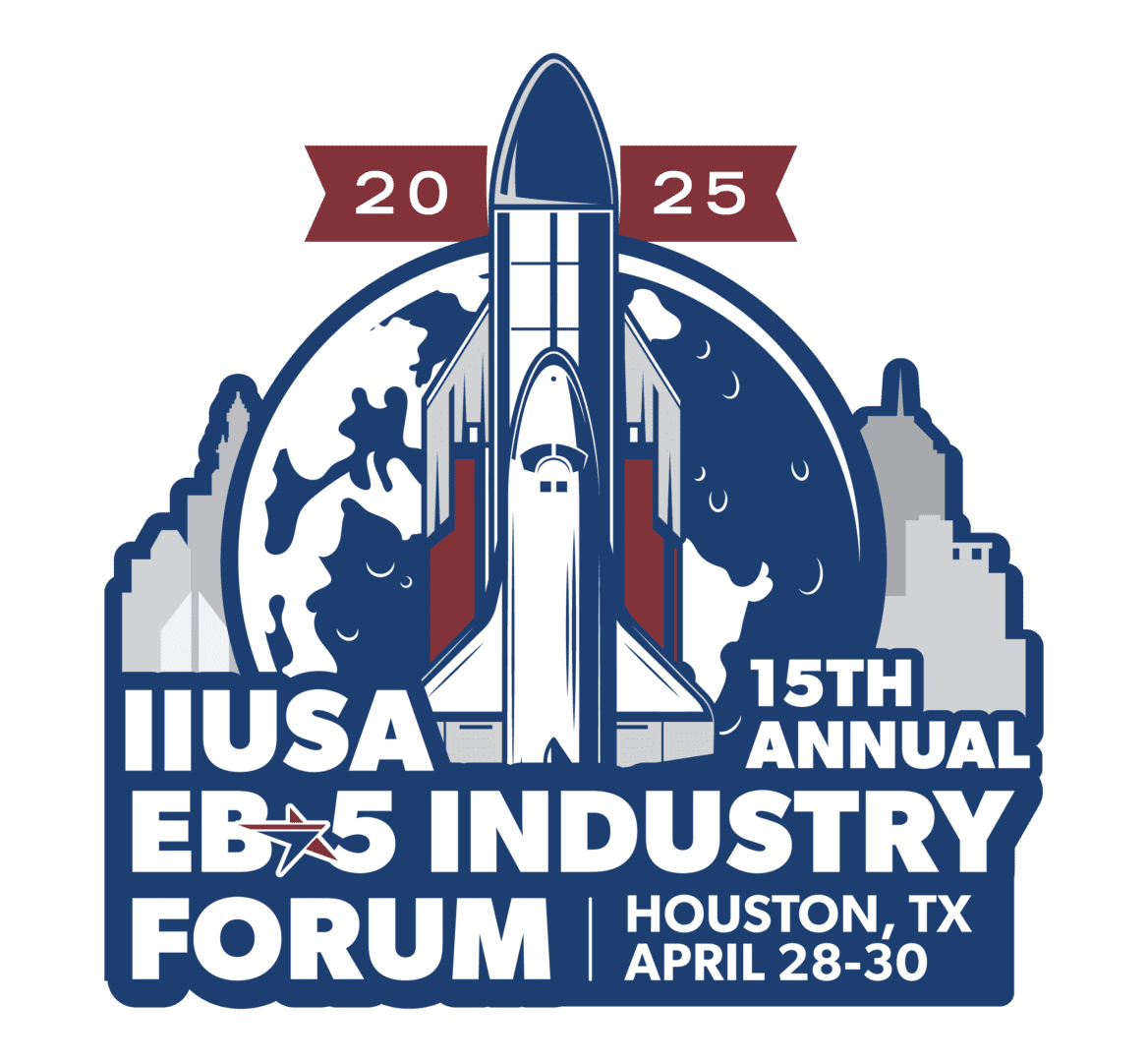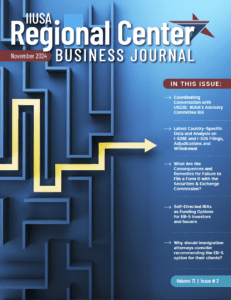This week, U.S. Citizenship and Immigration Services (USCIS) published talking points from the June 4th EB-5 Interactive Series Engagement on Expenses that are Includable (or Excludable) for Job Creation.
On the call, economists from the USCIS Immigrant Investor Program Office (IPO) gave a short presentation and the answered a number of non-case specific stakeholder questions concerning this topic.
*USCIS economists evaluate the evidence provided by an applicant or petitioner to determine if the proposal more likely than not conforms to the regulatory requirements.
* Regional centers may be designated based upon a general proposal for a project, which USCIS generally refers to as a hypothetical project.
* If the Form I-924 application contains more verifiable detail and includes a Matter of Ho compliant business plan, and/or the commercial enterprise’s organizational and transactional documents, the regional center may be designated with an actual or exemplar project. This designation accords deference to subsequent Form I-526 petitions involving the same project and material facts.
* The evidence necessary for economists to make a decision on whether and how to designate a regional center will also depend upon the organizational structure of the new commercial enterprise and job-creating entities, if any; the industries involved; and other factors.
*In order to make today’s stakeholder engagement as useful as possible, the rest of our presentation will focus on discussing the types of expenses that may or may not be includable in an input/output model, when such a model is presented with a Form I-924 actual and exemplar project filing, as well as Form I-526 petitions.
Direct, Indirect, and/or Induced Jobs (Note: Unless otherwise stated, references to “direct” or “indirect” refer to the legal definitions, not to references to the output of an economic model.)
* Direct jobs are jobs created directly by the new commercial enterprise, which must itself be the employer of the qualified employees who fill the positions. For example, if full-time staff at a hotel are in jobs created by the new commercial enterprise, but are employed by a separate job staffing firm, then those jobs would not be considered direct jobs.
* Indirect jobs are those that are held outside of the new commercial enterprise but are created as a result of it. For example, in a construction project, the jobs may be derived from expenses to backward linkages such as the purchase of building materials from various suppliers (concrete from one company, lumber from another, and so forth). Indirect jobs may also include induced jobs, which may be derived from forward linkages such as consumer spending by construction workers and operating staff using their incomes.
- As USCIS has stated in policy memos, due to the nature of accepted job creation modeling practices, which do not distinguish between full- or part-time jobs, USCIS relies upon the reasonable economic methodologies to determine whether, more likely than not, the indirect jobs were created.
- USCIS will not request additional evidence to validate to a greater level of certainty that the indirect jobs are full-time or permanent.
- USCIS may, however, request additional evidence to verify that the direct jobs are, or will be, full-time and permanent. This request may include a review of W-2s or similar evidence at the Form I-829 stage.
Eligible Hard Construction Expenditures, Soft Costs, and Transfers Hard Cost Construction Expenditures
*USCIS economists will typically ask for itemized information to ensure that only eligible costs are input into an accepted economic model or other methodology.
* Simply stated, total aggregate hard costs will likely be insufficient to demonstrate eligibility. Rather, costs should be broken down into specific expenditure categories (such as masonry work, plumbing, flooring, hardscaping, softscaping, etc.), so that USCIS economists can assess whether these costs are reasonable inputs.
* Certain types of evidence may strengthen the credibility of a filing. For example: If the assumptions are accompanied by a third-party market feasibility report, or if a developer shows a successful track record in completing similar projects. The important thing to remember is that the burden is on the petitioner to provide sufficient evidence.
Assessing Contingencies at the Form I-526 and I-829 Stages
*Generally speaking, USCIS considers contingency and reserve funds that adhere to acceptable industry practices to be permissible inputs into an economic model for estimating job creation.
* At the Form I-829 stage, USCIS will review whether contingency and reserve funds have actually been spent on eligible expenses.
Furniture, Fixtures and Equipment
*Furniture, fixtures, and equipment may be eligible expenditures as an input into an economic model.
* The applicable multiplier depends on the specific project type (for example, constructing a building vs. a ship).
Soft Cost Construction Expenditures
* A number of soft costs may be ineligible.
- For example, a stock market transaction that involves the exchange of two paper assets (i.e., money for shares of stock) creates no economic impact. Similarly, there are some transactional costs, such as brokerage fees for services related to the transfer payment transaction, that may not be eligible. Most petitioners do not request job creation from these categories.
- With respect to land purchases, there are some closing costs that may be eligible; however, the actual purchase of a title from the previous land owner does not create any economic activity, and is thus ineligible. Some transactional costs, such as realtor and title policy expenses, appraisals, site inspections and site clean-up, may be ineligible if they were incurred before the immigrant investor capital was placed at risk.
In terms of using funds from EB-5 investors to acquire real estate, Matter of Izummi requires that the “full amount of money must be made available to the business(es) most closely responsible for creating the employment upon which the petition is based.” For example, a job-creating entity may propose to allocate some EB-5 funds to purchasing land and other EB-5 funds to developing and operating a business on the purchased land. The jobs created by the enterprise can be apportioned among all the EB-5 investors. It is important to note, however, that real estate acquisition is not recognized as a jobcreating activity in and of itself.
Thus, it is not generally reasonable to treat funds spent on real estate acquisition as inputs to an employment impact model. Where some EB-5 funds will be used for real estate acquisition, such apportionment should be detailed in the business plan.
Note: USCIS does recognize that certain soft costs directly related to real estate transactions may reasonably be counted as valid job-creating expenditures and inputs to regional input/output models. In addition, soft costs related to the development and construction of EB-5-supported projects on designated land parcels may be considered on a case-by-case basis. If developer costs are used as a job creating input in an economic model, they should provide adequate detail to ensure that they are actually expenses that create jobs and not a return of a developer’s capital that will not create jobs within the project in review.
If the input/output model used in the economic impact analysis provides specific categories for the soft costs, the multiplier categories specific to these costs should be used instead of bundling such costs under general construction expenditures.
Architectural/Engineering Services
* Generally, USCIS finds it permissible to include architectural/engineering expenditures as an input into the economic model.
Legal fees
* Some legal fees are eligible, others are ineligible.
- USCIS has determined that legal fees related to complying with the EB-5 program or counseling immigrant investor clients are not permissible as inputs. However, legal fees related to counseling a business enterprise in the normal course of complying with local regulations, tax laws, employment laws and so forth are permissible as inputs.
- For regional center affiliated projects, eligible legal expenditures are permissible as an input into an economic model. The important thing to note here is that the input should be transparent, clarifying that only those legal costs not associated with EB-5 compliance are included
Financing Fees
* Similar to legal fees, some financing fees are ineligible when related to EB-5 capital. Financing fees from other loan or equity funding may be eligible.
Evidentiary Standard of Proof
* USCIS economists make a determination that a petitioner’s investment will more likely than not create the minimum number of required jobs within the requisite timeframe. Per the
May 2013 policy memo, I-924 actual projects “will be accorded deference to subsequent filings under the project involving the same material facts and issues.” Deference
will not apply, however, if there is “material change, fraud, willful misrepresentation, or a legally deficient determination” (pages 14-15).







